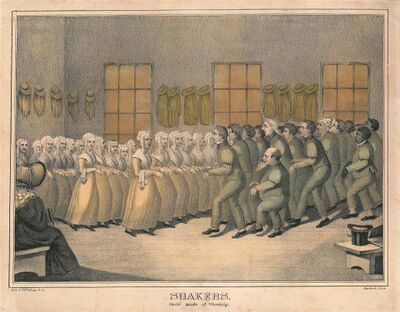Annotation:Square Order Shuffle: Difference between revisions
(Created page with "{{TuneAnnotation |f_annotation=s |f_source_for_notated_version=s |f_printed_sources=s |f_recorded_sources=s |f_see_also_listing=s }}") |
No edit summary |
||
| (3 intermediate revisions by the same user not shown) | |||
| Line 1: | Line 1: | ||
{{TuneAnnotation | {{TuneAnnotation | ||
|f_annotation= | |f_annotation=[[File:Squareorder.jpg|right|400px|thumb|The Square Order Shuffle]]'''SQUARE ORDER SHUFFLE.''' American, Jig (6/8 time). C Major. Standard tuning (fiddle). AABB. The "Square Order Shuffle," is a Shaker melody accompanying the first organized dance movement of the sect, was said to have been learned in 1785 by Father Joseph Meacham (the American born organizer of the Shakers) in a vision of angels | ||
|f_source_for_notated_version= | dancing before the throne of God. 16 The assembly was arranged in straight ranks; males and females sat facing one another. Described by Issac N. Youngs in an 1856 manuscript on the Shakers, the "shuffling manner" | ||
|f_printed_sources= | <blockquote> | ||
|f_recorded_sources= | ''...consisted in taking three whole steps forward, turning and taking'' | ||
|f_see_also_listing= | '''three back, setting the foot straight forward at each end and then'' | ||
''going forward again three steps, and taking a double step, or 'tip'' | |||
''tap' as it is called, then receding three steps with a 'tip tap'; this'' | |||
''takes the turn part of the tune once, then it is repeated, in the'' | |||
''same manner, then shuffle the set part once over.'' | |||
</blockquote> | |||
"Meecham sought to control and contain the expression of religious feeling by introducing dances such as “Square-Order Shuffle” and “The March”, which requiring rigid, precise movements and synchronized steps, not unlike country dancing. Meacham, despite the Shakers’ practice of celibacy, wanted the sexes to interact, to create spiritual and temporal families to build strong communities. The dances brought Shaker brothers and sisters, including children, into proximity without allowing them to touch each other. Meacham wanted them to be mindful of the temptations they had denied to become Shakers"<ref>Julie Nicoletta, “The Gendering of Order and Disorder: Mother Ann Lee and Shaker Architecture,” The New England Quarterly, Vol. 74, No. 2 (Jun., 2001), p. 305]</ref>. | |||
|f_source_for_notated_version= | |||
|f_printed_sources=Miller ('''Fiddler’s Throne'''), 2004; No. 101, p. 70. | |||
|f_recorded_sources= | |||
|f_see_also_listing= | |||
}} | }} | ||
Latest revision as of 02:31, 14 May 2024
X:1 T:Square Order Shuffle M:6/8 L:1/8 R:Shaker Dance N:”By a convert ‘young in the faith’ at Enfield, Conn., 1825.” S:Jean Simmonds, "Shaker Music as a Genre of Folk Music" (p. 16); paper submitted S:to course "Folk Studies 476, Burt Feintuch", Western Kentucky University. K:Amin !fermata!A2-|:A|A2d dcd|c-AG A3|AGF EDC|(DED) A,2A| A2d dcd|(cA)G A3|AGF EDC|D3 D2:| |:D|DCD A,2-A,|F2G A3|AGF EDC|DED A,2 (B,/C/)| DCD A,2A,|F2G A3|AGF EDC|D3D2:|

dancing before the throne of God. 16 The assembly was arranged in straight ranks; males and females sat facing one another. Described by Issac N. Youngs in an 1856 manuscript on the Shakers, the "shuffling manner"
...consisted in taking three whole steps forward, turning and taking 'three back, setting the foot straight forward at each end and then going forward again three steps, and taking a double step, or 'tip tap' as it is called, then receding three steps with a 'tip tap'; this takes the turn part of the tune once, then it is repeated, in the same manner, then shuffle the set part once over.
"Meecham sought to control and contain the expression of religious feeling by introducing dances such as “Square-Order Shuffle” and “The March”, which requiring rigid, precise movements and synchronized steps, not unlike country dancing. Meacham, despite the Shakers’ practice of celibacy, wanted the sexes to interact, to create spiritual and temporal families to build strong communities. The dances brought Shaker brothers and sisters, including children, into proximity without allowing them to touch each other. Meacham wanted them to be mindful of the temptations they had denied to become Shakers"[1].
- ↑ Julie Nicoletta, “The Gendering of Order and Disorder: Mother Ann Lee and Shaker Architecture,” The New England Quarterly, Vol. 74, No. 2 (Jun., 2001), p. 305]

